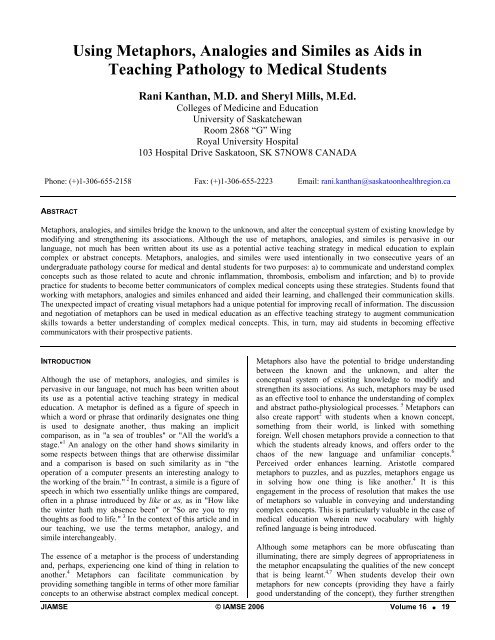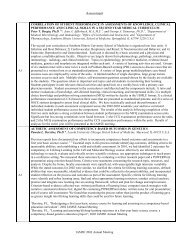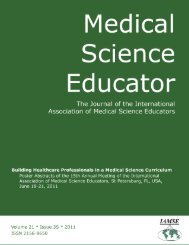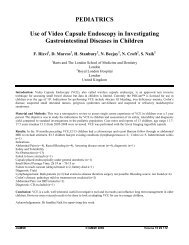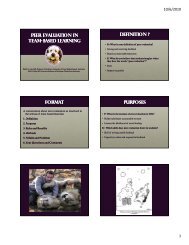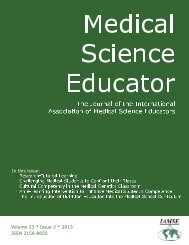Using Metaphors, Analogies and Similes as Aids in ... - IAMSE
Using Metaphors, Analogies and Similes as Aids in ... - IAMSE
Using Metaphors, Analogies and Similes as Aids in ... - IAMSE
Create successful ePaper yourself
Turn your PDF publications into a flip-book with our unique Google optimized e-Paper software.
<strong>Us<strong>in</strong>g</strong> <strong>Metaphors</strong>, <strong>Analogies</strong> <strong>and</strong> <strong>Similes</strong> <strong>as</strong> <strong>Aids</strong> <strong>in</strong>Teach<strong>in</strong>g Pathology to Medical StudentsRani Kanthan, M.D. <strong>and</strong> Sheryl Mills, M.Ed.Colleges of Medic<strong>in</strong>e <strong>and</strong> EducationUniversity of S<strong>as</strong>katchewanRoom 2868 “G” W<strong>in</strong>gRoyal University Hospital103 Hospital Drive S<strong>as</strong>katoon, SK S7NOW8 CANADAPhone: (+)1-306-655-2158 Fax: (+)1-306-655-2223 Email: rani.kanthan@s<strong>as</strong>katoonhealthregion.caABSTRACT<strong>Metaphors</strong>, analogies, <strong>and</strong> similes bridge the known to the unknown, <strong>and</strong> alter the conceptual system of exist<strong>in</strong>g knowledge bymodify<strong>in</strong>g <strong>and</strong> strengthen<strong>in</strong>g its <strong>as</strong>sociations. Although the use of metaphors, analogies, <strong>and</strong> similes is perv<strong>as</strong>ive <strong>in</strong> ourlanguage, not much h<strong>as</strong> been written about its use <strong>as</strong> a potential active teach<strong>in</strong>g strategy <strong>in</strong> medical education to expla<strong>in</strong>complex or abstract concepts. <strong>Metaphors</strong>, analogies, <strong>and</strong> similes were used <strong>in</strong>tentionally <strong>in</strong> two consecutive years of anundergraduate pathology course for medical <strong>and</strong> dental students for two purposes: a) to communicate <strong>and</strong> underst<strong>and</strong> complexconcepts such <strong>as</strong> those related to acute <strong>and</strong> chronic <strong>in</strong>flammation, thrombosis, embolism <strong>and</strong> <strong>in</strong>farction; <strong>and</strong> b) to providepractice for students to become better communicators of complex medical concepts us<strong>in</strong>g these strategies. Students found thatwork<strong>in</strong>g with metaphors, analogies <strong>and</strong> similes enhanced <strong>and</strong> aided their learn<strong>in</strong>g, <strong>and</strong> challenged their communication skills.The unexpected impact of creat<strong>in</strong>g visual metaphors had a unique potential for improv<strong>in</strong>g recall of <strong>in</strong>formation. The discussion<strong>and</strong> negotiation of metaphors can be used <strong>in</strong> medical education <strong>as</strong> an effective teach<strong>in</strong>g strategy to augment communicationskills towards a better underst<strong>and</strong><strong>in</strong>g of complex medical concepts. This, <strong>in</strong> turn, may aid students <strong>in</strong> becom<strong>in</strong>g effectivecommunicators with their prospective patients.INTRODUCTIONAlthough the use of metaphors, analogies, <strong>and</strong> similes isperv<strong>as</strong>ive <strong>in</strong> our language, not much h<strong>as</strong> been written aboutits use <strong>as</strong> a potential active teach<strong>in</strong>g strategy <strong>in</strong> medicaleducation. A metaphor is def<strong>in</strong>ed <strong>as</strong> a figure of speech <strong>in</strong>which a word or phr<strong>as</strong>e that ord<strong>in</strong>arily designates one th<strong>in</strong>gis used to designate another, thus mak<strong>in</strong>g an implicitcomparison, <strong>as</strong> <strong>in</strong> "a sea of troubles" or "All the world's <strong>as</strong>tage." 1 An analogy on the other h<strong>and</strong> shows similarity <strong>in</strong>some respects between th<strong>in</strong>gs that are otherwise dissimilar<strong>and</strong> a comparison is b<strong>as</strong>ed on such similarity <strong>as</strong> <strong>in</strong> “theoperation of a computer presents an <strong>in</strong>terest<strong>in</strong>g analogy tothe work<strong>in</strong>g of the bra<strong>in</strong>." 2 In contr<strong>as</strong>t, a simile is a figure ofspeech <strong>in</strong> which two essentially unlike th<strong>in</strong>gs are compared,often <strong>in</strong> a phr<strong>as</strong>e <strong>in</strong>troduced by like or <strong>as</strong>, <strong>as</strong> <strong>in</strong> "How likethe w<strong>in</strong>ter hath my absence been" or "So are you to mythoughts <strong>as</strong> food to life." 3 In the context of this article <strong>and</strong> <strong>in</strong>our teach<strong>in</strong>g, we use the terms metaphor, analogy, <strong>and</strong>simile <strong>in</strong>terchangeably.The essence of a metaphor is the process of underst<strong>and</strong><strong>in</strong>g<strong>and</strong>, perhaps, experienc<strong>in</strong>g one k<strong>in</strong>d of th<strong>in</strong>g <strong>in</strong> relation toanother. 4 <strong>Metaphors</strong> can facilitate communication byprovid<strong>in</strong>g someth<strong>in</strong>g tangible <strong>in</strong> terms of other more familiarconcepts to an otherwise abstract complex medical concept.<strong>Metaphors</strong> also have the potential to bridge underst<strong>and</strong><strong>in</strong>gbetween the known <strong>and</strong> the unknown, <strong>and</strong> alter theconceptual system of exist<strong>in</strong>g knowledge to modify <strong>and</strong>strengthen its <strong>as</strong>sociations. As such, metaphors may be used<strong>as</strong> an effective tool to enhance the underst<strong>and</strong><strong>in</strong>g of complex<strong>and</strong> abstract patho-physiological processes. 5 <strong>Metaphors</strong> canalso create rapport 2 with students when a known concept,someth<strong>in</strong>g from their world, is l<strong>in</strong>ked with someth<strong>in</strong>gforeign. Well chosen metaphors provide a connection to thatwhich the students already knows, <strong>and</strong> offers order to thechaos of the new language <strong>and</strong> unfamiliar concepts. 6Perceived order enhances learn<strong>in</strong>g. Aristotle comparedmetaphors to puzzles, <strong>and</strong> <strong>as</strong> puzzles, metaphors engage us<strong>in</strong> solv<strong>in</strong>g how one th<strong>in</strong>g is like another. 4 It is thisengagement <strong>in</strong> the process of resolution that makes the useof metaphors so valuable <strong>in</strong> convey<strong>in</strong>g <strong>and</strong> underst<strong>and</strong><strong>in</strong>gcomplex concepts. This is particularly valuable <strong>in</strong> the c<strong>as</strong>e ofmedical education where<strong>in</strong> new vocabulary with highlyref<strong>in</strong>ed language is be<strong>in</strong>g <strong>in</strong>troduced.Although some metaphors can be more obfuscat<strong>in</strong>g thanillum<strong>in</strong>at<strong>in</strong>g, there are simply degrees of appropriateness <strong>in</strong>the metaphor encapsulat<strong>in</strong>g the qualities of the new conceptthat is be<strong>in</strong>g learnt. 4,7 When students develop their ownmetaphors for new concepts (provid<strong>in</strong>g they have a fairlygood underst<strong>and</strong><strong>in</strong>g of the concept), they further strengthenJ<strong>IAMSE</strong> © <strong>IAMSE</strong> 2006 Volume 16 19
Figure 1. Outl<strong>in</strong>e of the <strong>in</strong>tentional use of metaphors <strong>in</strong> the <strong>in</strong>structional teach<strong>in</strong>g of pathology to undergraduatemedical students.<strong>Us<strong>in</strong>g</strong> Metaphor <strong>in</strong> Teach<strong>in</strong>g Undergraduate PathologyTeachermademetaphorsOpen-ended<strong>Metaphors</strong>StudentmademetaphorsForced<strong>Metaphors</strong>Inflammation,Thrombosis,Embolism,InfarctionVisual<strong>Metaphors</strong>their underst<strong>and</strong><strong>in</strong>gs because they are (a) negotiat<strong>in</strong>g theappropriateness of the metaphor they are work<strong>in</strong>g with, <strong>and</strong>(b) arrang<strong>in</strong>g their underst<strong>and</strong><strong>in</strong>gs <strong>in</strong> personally mean<strong>in</strong>gfulways. 5<strong>Metaphors</strong> were used <strong>in</strong>tentionally <strong>in</strong> teach<strong>in</strong>gundergraduate pathology to medical <strong>and</strong> dental students fortwo consecutive years (Figure 1). The pr<strong>in</strong>ciple <strong>in</strong>tentions<strong>in</strong>cluded:1. Incorporat<strong>in</strong>g open-ended, forced, <strong>and</strong> visualmetaphors to teach complex concepts (e.g. acute <strong>and</strong>chronic <strong>in</strong>flammation, thrombosis, embolism <strong>and</strong><strong>in</strong>farction);2. Involv<strong>in</strong>g students <strong>in</strong> a creative dynamic thoughtprocess to enhance underst<strong>and</strong><strong>in</strong>g of such complexmedical concepts; <strong>and</strong>3. Provid<strong>in</strong>g students with a forum to practice thecommunication of complex medical concepts throughthe jo<strong>in</strong>t exploration of metaphors, analogies, <strong>and</strong>similes <strong>in</strong> terms of other th<strong>in</strong>gs with which they weremore comfortable <strong>and</strong> familiar.MATERIALS AND METHODSThis study w<strong>as</strong> <strong>in</strong>itiated <strong>and</strong> carried out by the coursecoord<strong>in</strong>ator <strong>in</strong> keep<strong>in</strong>g with her ongo<strong>in</strong>g <strong>in</strong>terest <strong>in</strong>develop<strong>in</strong>g a repertoire of <strong>in</strong>structional methodologies thatengage medical students <strong>in</strong> their own learn<strong>in</strong>g. The <strong>in</strong>structorh<strong>as</strong> worked on this project with a coach <strong>and</strong> co-author of thispaper, a doctoral c<strong>and</strong>idate <strong>in</strong> Educational Adm<strong>in</strong>istration, <strong>as</strong>part of their on-go<strong>in</strong>g <strong>in</strong>terest <strong>in</strong> active learn<strong>in</strong>g <strong>in</strong> themedical curriculum. 7This <strong>in</strong>structor, who <strong>in</strong>tentionally <strong>in</strong>corporated metaphor,analogy <strong>and</strong> simile, taught 13 of the 22 cl<strong>as</strong>ses <strong>in</strong> the Year2003 <strong>and</strong> 12 of the 22 cl<strong>as</strong>ses <strong>in</strong> the Year 2004. In bothyears, these sessions formed a block series of lecturesoccurr<strong>in</strong>g from the beg<strong>in</strong>n<strong>in</strong>g of the course to the midtermexam thereby ma<strong>in</strong>ta<strong>in</strong><strong>in</strong>g cont<strong>in</strong>uity of communication.Dur<strong>in</strong>g the first year of study there were 88 students enrolled<strong>in</strong> the 6-credit course: 60 second year medical students, 26second year dental students, <strong>and</strong> 2 graduate students. Dur<strong>in</strong>gthe second year of study there were 63 second year medicalstudents, 27 second year dental students, <strong>and</strong> 2 graduatestudents.Instructional Metaphor ExamplesThe <strong>in</strong>structor first modeled the use of metaphors bypepper<strong>in</strong>g her traditional lecture with explicit metaphorical<strong>and</strong> analogous examples:1. For <strong>in</strong>flammation, the <strong>in</strong>structor used a sportsanalogy. Although start<strong>in</strong>g with tennis, a game she isfamiliar with, she quickly made a switch to football<strong>and</strong> hockey when it became apparent that the<strong>in</strong>tricacies of tennis were not familiar to manystudents. She discussed the medical concepts ofexudation, transudation, edema, <strong>and</strong> pus by us<strong>in</strong>g thesports vernacular <strong>and</strong> language (i.e. game strategyplans). She <strong>in</strong>dicated how the game strategiesparalleled those of the body <strong>in</strong> <strong>in</strong>flammation <strong>in</strong> termsof:J<strong>IAMSE</strong> © <strong>IAMSE</strong> 2006 Volume 16 20
Figure 2. Recipe card for thrombosis.absorbed water, it caused the flush to act <strong>in</strong>unpredictable ways. The ball <strong>in</strong>termittently obstructedthe “flow” with the f<strong>in</strong>al result be<strong>in</strong>g a completebreakdown <strong>and</strong> an almighty flood<strong>in</strong>g mess. Thisprocess w<strong>as</strong> likened to the fate of a thrombusresult<strong>in</strong>g <strong>in</strong> the various possibilities rang<strong>in</strong>g from noeffect to <strong>in</strong>termittent blockage to full blown <strong>in</strong>farctionwith complete breakdown of normal structure <strong>and</strong>order.• where the sport or game w<strong>as</strong> played. Thev<strong>as</strong>cularized connective tissue became theplay<strong>in</strong>g field;• the teams were Team A (the circulat<strong>in</strong>g cells <strong>in</strong>vessels –neutrophils, eos<strong>in</strong>iphils, b<strong>as</strong>ophils, <strong>and</strong>platelets) <strong>and</strong> Team B (the connective tissue cells-- m<strong>as</strong>t cells, resident macrophages, <strong>and</strong>lymphocytes); <strong>and</strong>• the extracellular matrix, composed of structuralfibrous prote<strong>in</strong>s, adhesive glycoprote<strong>in</strong>s <strong>and</strong>b<strong>as</strong>ement membranes, became the “reserves” onthe “bench.”The <strong>in</strong>structor likened the “quick kill” of acute<strong>in</strong>flammation to a “blow out” <strong>in</strong> hockey <strong>as</strong> opposed tochronic <strong>in</strong>flammation that resembled repeatedovertimes <strong>in</strong> hockey. In tennis, chronic<strong>in</strong>flammations, like persistent <strong>in</strong>fections <strong>and</strong>autoimmune dise<strong>as</strong>es, were described <strong>as</strong> more closelyresembl<strong>in</strong>g the prolonged agony of a 5 set tennismatch with alternat<strong>in</strong>g deuce/match po<strong>in</strong>ts, while,acute <strong>in</strong>flammation w<strong>as</strong> likened to w<strong>in</strong>n<strong>in</strong>g <strong>in</strong> threestraight sets.2. The pathogenesis of thrombosis w<strong>as</strong> demonstratedus<strong>in</strong>g a toilet roll for a vessel lumen with “Smarties”<strong>as</strong> cells-- white blood cells, red blood cells, <strong>and</strong> blueplatelets -- stuck to its <strong>in</strong>terior. This actual model w<strong>as</strong>held up <strong>as</strong> it w<strong>as</strong> created <strong>and</strong> expla<strong>in</strong>ed <strong>in</strong> cl<strong>as</strong>s. Aglue stick w<strong>as</strong> used to “<strong>in</strong>jure” the endothelium sothat different cells could “stick” to the <strong>in</strong>side. Thefibr<strong>in</strong> mesh w<strong>as</strong> illustrated with red “Twizzlers.” Arecipe card for thrombosis w<strong>as</strong> shown concurrently.(Figure 2)3. For embolism, the students were <strong>as</strong>ked to create threescenarios for the “perfect murder” us<strong>in</strong>g the pr<strong>in</strong>ciplesof embolism.4. Thrombus / Infarction became a plumb<strong>in</strong>g blockageor the “loo” gett<strong>in</strong>g blocked. Students were presentedwith a situation where a tennis ball had found its way<strong>in</strong>to the “S” shaped bend of the toilet bowl. As itStudent-developed <strong>Metaphors</strong>As cl<strong>as</strong>ses progressed, students were <strong>as</strong>ked to work <strong>in</strong> small,<strong>in</strong>formal groups to develop visual <strong>and</strong> verbal metaphors thatl<strong>in</strong>ked the pathology concepts be<strong>in</strong>g presented <strong>in</strong> the lectureto common visual or verbal concepts. As well <strong>as</strong> provid<strong>in</strong>g abreak <strong>in</strong> the flow of lecture <strong>in</strong>formation, it gave students anopportunity to reflect, discuss, <strong>and</strong> <strong>in</strong>corporate new concepts<strong>in</strong>to their exist<strong>in</strong>g conceptual paradigms. The students hadtime <strong>in</strong> cl<strong>as</strong>s to negotiate metaphors that illustrated theconcept through these dialogues. For the verbal metaphors,students were <strong>as</strong>ked to consider how the concept w<strong>as</strong> like x<strong>and</strong> not like x. In the “open-ended metaphor,” students weregiven the abstract medical concept, <strong>and</strong> were free to choose<strong>and</strong> develop the analogue for the concept. For “forced”metaphors, all students worked with the same analogue.They were given both the concept <strong>and</strong> the other half of themetaphor to which they had to provide support<strong>in</strong>g evidencefor the analogue.“Visual metaphors” were developed <strong>and</strong> expla<strong>in</strong>ed throughdraw<strong>in</strong>gs <strong>and</strong> pictures that were not <strong>in</strong>tended to be literalrepresentations of the concept. It w<strong>as</strong> hoped that explor<strong>in</strong>g<strong>and</strong> negotiat<strong>in</strong>g the characteristics of new complex medicalconcepts through discussion <strong>and</strong> dialogue with metaphorswould help to cement these ide<strong>as</strong> while provid<strong>in</strong>g a modelthat could be used to clarify medical complexities withpatients <strong>in</strong> the future. Students worked <strong>in</strong> groups to choosean analogue, discuss <strong>and</strong> negotiate its merits, <strong>and</strong> then drawit. The draw<strong>in</strong>gs were collected at the end of the cl<strong>as</strong>s <strong>and</strong>reviewed by the <strong>in</strong>structor. In this way, the <strong>in</strong>structor couldclear up any misconceptions. Samples of the studentresponses to the activities were often shared with the largegroup at the beg<strong>in</strong>n<strong>in</strong>g of the next cl<strong>as</strong>s. Students requestedto hear how others had responded <strong>and</strong> shar<strong>in</strong>g theseresponses seemed to spark enthusi<strong>as</strong>m <strong>in</strong> cl<strong>as</strong>s.Data Gather<strong>in</strong>g.We gathered student responses to the <strong>in</strong>clusion of metaphorsat different po<strong>in</strong>ts <strong>in</strong> each cl<strong>as</strong>s <strong>as</strong> part of our on-go<strong>in</strong>g<strong>in</strong>vestigation <strong>in</strong>to the <strong>in</strong>clusion of active learn<strong>in</strong>g. As the<strong>in</strong>structor had no further direct teach<strong>in</strong>g responsibilities <strong>in</strong>this course after the midterm, <strong>in</strong> both years, the students’perceptions of <strong>in</strong>corporat<strong>in</strong>g analogy <strong>and</strong> metaphor weregathered <strong>in</strong> the Midterm Evaluation/Reflectionquestionnaire 7 at the midterm exam. In Year 2003, thequestionnaire <strong>in</strong>cluded room for open-ended responses aboutthe positive, the negative, <strong>and</strong> the <strong>in</strong>terest<strong>in</strong>g <strong>as</strong>pects of thecourse. There w<strong>as</strong> also space for “other” comments. In Year2004, the questionnaire had no open-ended questions. Thequestionnaires were collated <strong>and</strong> the comments wereJ<strong>IAMSE</strong> © <strong>IAMSE</strong> 2006 Volume 16 21
Figure 3. Examples of student developed open-ended metaphors, analogies, <strong>and</strong> similes on acute <strong>in</strong>flammation.Acute <strong>in</strong>flammation is like the ARMY because…Acute <strong>in</strong>flammation is not like the ARMY because…1. There’s a 1st l<strong>in</strong>e of defense (soldiers) → circulat<strong>in</strong>g cells <strong>in</strong> 1. Soldiers won’t fight until ordered to (<strong>in</strong>flammation occursvesselsnaturally)2. 2nd l<strong>in</strong>e of defense: artillery (CT cells) 2. Both sides kill each other, both sides die (Microorganisms<strong>and</strong> leukocytes phagocytose <strong>in</strong>vad<strong>in</strong>g organism but organismdoesn’t eat leukocytes)3. Army reserves (extracellular matrix) 3. In army wars aren’t over when opponent dies: peace keep<strong>in</strong>gaftermath etc. (<strong>in</strong>flammation over once organism resolved).Acute <strong>in</strong>flammation is like WAR because…Acute <strong>in</strong>flammation is not like WAR because…1. The “enemy is the bacteria/<strong>in</strong>fection 1. Wars usually l<strong>as</strong>t a very long time while acute <strong>in</strong>flammationl<strong>as</strong>ts a short time2. The “soldiers” are the immune response cells who share a 2. Wars can end <strong>in</strong> a truce but there is always a “loser” <strong>in</strong> acutecommon “battlefield” which is the organism<strong>in</strong>flammation3. There are two sides of the battle (the <strong>in</strong>jury/<strong>in</strong>flammation <strong>and</strong> 3. There is potential for <strong>in</strong>flammation to turn on itself the hostthe cells ie. circulat<strong>in</strong>g <strong>and</strong> connective tissue cells) <strong>and</strong> the if it is dysfunctionaltwo sides possess strategies. The body’s cells send certa<strong>in</strong>troops (ie. groups of cell/types of cell) to fight certa<strong>in</strong> battles.For example Eos<strong>in</strong>ophils are sent to battle hypersensitivity.Acute <strong>in</strong>flammation is like DATING because…Acute <strong>in</strong>flammation is not like DATING because…1. Chemok<strong>in</strong>es attract leukocytes like pheromones attract a 1. You don’t engulf/enter your datepartner2. Pavement<strong>in</strong>g is like speed dat<strong>in</strong>g 2. Not try<strong>in</strong>g to accumulate <strong>as</strong> many photrus <strong>as</strong> possible3. Leukocyte adhesion is like marriage <strong>in</strong> that it usually ends <strong>in</strong>destruction3. A roll <strong>in</strong> the hay is more turbulent than leukocyte roll<strong>in</strong>galong vessel wallAcute <strong>in</strong>flammation is like SEX because…Acute <strong>in</strong>flammation is not like SEX because…1. Protection can prevent undesirable consequences 1. Once the performance is over it can be done aga<strong>in</strong> <strong>and</strong> aga<strong>in</strong>2. Involves stimulus <strong>and</strong> response 2. Only requires two people <strong>as</strong> opposed to many parties3. Involves chemical attractants, pheremones 3. Inflammation is pa<strong>in</strong>fulAcute <strong>in</strong>flammation is like SHOPPING because…Acute <strong>in</strong>flammation is not like SHOPPING because…1. You roll around look<strong>in</strong>g for someth<strong>in</strong>g you like 1. Shopp<strong>in</strong>g you can th<strong>in</strong>k it over2. When you see it you are attracted <strong>and</strong> move to it 2. You don’t get swell<strong>in</strong>g usually with shopp<strong>in</strong>g3. You buy (engulf) it →the pa<strong>in</strong> comes later with the bill 3. Pus is bad when shopp<strong>in</strong>gAcute <strong>in</strong>flammation is like COOKING because…1. You have to follow the order of add<strong>in</strong>g <strong>in</strong>gredients <strong>as</strong> thev<strong>as</strong>cular changes must follow an orderly sequence2. You have to have the right <strong>in</strong>gredients <strong>and</strong> the rightmediators/cell types3. Add<strong>in</strong>g too much bak<strong>in</strong>g powder is like hav<strong>in</strong>g anexcessive/out of control <strong>in</strong>flammatory responseAcute <strong>in</strong>flammation is not like COOKING because…1. In cook<strong>in</strong>g everybody w<strong>in</strong>s, there is no conflict <strong>and</strong> hopefullyno one gets killed2. In cook<strong>in</strong>g you can use many recipes to make the same dishbut <strong>in</strong>flammation requires all key players3. The whole dish is cooked but <strong>in</strong>flammation is localanalyzed us<strong>in</strong>g simple me<strong>as</strong>ures such <strong>as</strong> median,percentages, averages, <strong>and</strong> range of student comments thatwere categorized for over-rid<strong>in</strong>g themes. Another form ofevaluation <strong>in</strong>cluded a question on the midterm exam directlytest<strong>in</strong>g the application of metaphor to the material coveredby this <strong>in</strong>structor. The students’ f<strong>in</strong>al marks for years 2000-2003 (Table 1) were comparable. This w<strong>as</strong> <strong>in</strong> keep<strong>in</strong>g withthe performance at the midterm <strong>as</strong> published previously. 7Therefore, we concluded that the changes <strong>in</strong> <strong>in</strong>structionalstyles did not adversely affect the students’ performance <strong>as</strong> awhole.In Year 2004, the data collected from this second group ofstudents w<strong>as</strong> more extensive than from the first. It w<strong>as</strong> <strong>as</strong> aresult of the responses of the first group of students that wedecided to try this method aga<strong>in</strong> <strong>and</strong> <strong>in</strong>vestigate morethoroughly. In addition to the questionnaire at the midtermexam, feedback w<strong>as</strong> garnered from the students <strong>in</strong> the Year2004 section halfway to the midterm by <strong>as</strong>k<strong>in</strong>g what theywould like to see stopped (STOP), what they would like the<strong>in</strong>structor to add (START), <strong>and</strong> what they would like to seecont<strong>in</strong>ued (CONTINUE). 7At the midterm exam<strong>in</strong>ation the use of metaphors, analogies,<strong>and</strong> similes <strong>as</strong> a communication tool for expla<strong>in</strong><strong>in</strong>g complexmedical concepts to patients <strong>in</strong> cl<strong>in</strong>ical practice w<strong>as</strong> alsoevaluated by written responses generated to short answerquestions (SAQs) <strong>as</strong> seen <strong>in</strong> the example below:J<strong>IAMSE</strong> © <strong>IAMSE</strong> 2006 Volume 16 22
Figure 4. Examples of student developed forced metaphors, analogies, <strong>and</strong> similes on acute <strong>in</strong>flammation to a “TIMBIT”.Acute <strong>in</strong>flammation is like a “TIMBIT” because…• like a macrophage, because if you were to put severalTimbits together, you would get a doughnut (severalmacrophages → a giant cell)• the aroma of Timbits are like chemoattracts because theydraw people to them• Timbits come <strong>in</strong> several varieties so do immune cells• h<strong>as</strong> a shell of sugar like a granuloma h<strong>as</strong> a shell ofepitheliod macrophages• variety of cells <strong>in</strong>volved <strong>in</strong> <strong>in</strong>flammation just like thevariety of flavours of Timbits• timbits are usually <strong>as</strong>sociated with other chemicalmediators (ie. caffe<strong>in</strong>e)• Roll<strong>in</strong>g – you can roll the Timbit around <strong>in</strong> your h<strong>and</strong> ortongue• People phagocytose timbits just like neutrophils eat<strong>in</strong>gantigens• Timbits are sticky, just like activated leukocytes• You are chemotactically attracted to it <strong>and</strong> go <strong>in</strong> for thekill• Timbits <strong>and</strong> WBCs are round• Many Timbits marg<strong>in</strong>ate <strong>and</strong> roll <strong>in</strong> my belly• Adhesion – the glaze from the Timbit wants to sticks toyour tongue• Chemotaxis – the Timbits presence <strong>in</strong> your mouth attractssalivary juices from salivary gl<strong>and</strong>sAcute <strong>in</strong>flammation is not like a “TIMBIT” because…• immune cells elicit different responses because ofdifferent stimuli (ex; par<strong>as</strong>ite elicits eos<strong>in</strong>ophilicreaction), but Timbits only elicit one response, satiat<strong>in</strong>ghunger• <strong>in</strong>flammation requires energy to be expended, where<strong>as</strong>Timbits are a source of energy• Timbits are not pa<strong>in</strong>ful• <strong>in</strong>flammation is free – Timbits aren’t (unless they’regiven out <strong>in</strong> cl<strong>as</strong>s)• Timbits come <strong>in</strong> boxes of 20, <strong>in</strong>flammation comes <strong>in</strong> anysize needed• chronic <strong>in</strong>flammation from <strong>in</strong>fection will make yousk<strong>in</strong>ny, Timbits make you fat• <strong>in</strong>flammation t<strong>as</strong>tes, smells bad <strong>and</strong> Timbits t<strong>as</strong>tes, smellsgood• you can only f<strong>in</strong>d Timbits at Tim Horton’s, you can f<strong>in</strong>d<strong>in</strong>flammation all over the body• Timbits don’t have prote<strong>in</strong>• Timbits build tissue not damage them• Eat<strong>in</strong>g a Timbit is enjoyable, <strong>in</strong>flammation is pa<strong>in</strong>ful• Timbits are cold, <strong>in</strong>flammation is hot• Inflammation is exothermic but Timbit digestion isendothermic• Leukocyte can be activated <strong>and</strong> emigrate to the focus of<strong>in</strong>flammation. Timbit can’t move by itselfA 15-year old lad suffer<strong>in</strong>g from familialhypercholesterolemia is referred to your cl<strong>in</strong>ic for aconsultation. <strong>Us<strong>in</strong>g</strong> verbal <strong>and</strong> / or visual metaphors <strong>as</strong>practiced <strong>in</strong> cl<strong>as</strong>s:a) Summarize the key concepts of the pathogenesis ofatherosclerosis (2 marks); <strong>and</strong>b) Expla<strong>in</strong> the etiopathogenesis of this dise<strong>as</strong>e <strong>in</strong>clud<strong>in</strong>grisk factors (2 marks).RESULTS AND DISCUSSIONThe follow<strong>in</strong>g are discussed <strong>in</strong> this section:1. Student-developed metaphors;2. Student reactions to the use of metaphors <strong>as</strong> an<strong>in</strong>structional tool;3. The potential of us<strong>in</strong>g metaphor <strong>as</strong> a communicationtool; <strong>and</strong>4. Challenges <strong>and</strong> risks <strong>in</strong>volved <strong>in</strong> us<strong>in</strong>g metaphors.1. Student-developed metaphors. Students <strong>in</strong> both yearsparticipated <strong>in</strong> the cl<strong>as</strong>sroom activities with vary<strong>in</strong>g degreesof enthusi<strong>as</strong>m. There appeared to be engagement <strong>in</strong> theactivities <strong>and</strong> a good deal of productive “buzz” <strong>in</strong> the lecturetheatre dur<strong>in</strong>g the activities.Open-ended metaphors. When students were <strong>as</strong>ked toconsider three ways <strong>in</strong> which acute <strong>in</strong>flammation w<strong>as</strong> like x<strong>and</strong> three ways that acute <strong>in</strong>flammation w<strong>as</strong> not like x, theydevised their own metaphors b<strong>as</strong>ed on th<strong>in</strong>gs they knew <strong>and</strong>valued, <strong>and</strong> were thus able to arrange their learn<strong>in</strong>gexperiences by strengthen<strong>in</strong>g underst<strong>and</strong><strong>in</strong>g by l<strong>in</strong>k<strong>in</strong>gsometh<strong>in</strong>g from their world with the newly presentedabstract concepts <strong>in</strong> personally mean<strong>in</strong>gful ways. 5 Thestudents’ metaphors for acute <strong>in</strong>flammation clustered around6 ma<strong>in</strong> themes:1. <strong>in</strong>terpersonal dynamics (<strong>in</strong>clud<strong>in</strong>g sex/dat<strong>in</strong>g) 35%2. war <strong>and</strong> other forms of conflict 18%3. regular daily activities 16%4. sports (although they had been steered away 14%from this)5. natural phenomena 11%6. music <strong>and</strong> concerts 5%A few examples of student-developed open-ended verbalmetaphors for acute <strong>in</strong>flammation are illustrated <strong>in</strong> Figure 3.J<strong>IAMSE</strong> © <strong>IAMSE</strong> 2006 Volume 16 23
Students enjoyed hear<strong>in</strong>g what their peers had created at thebeg<strong>in</strong>n<strong>in</strong>g of the next cl<strong>as</strong>s <strong>and</strong> this also served <strong>as</strong> a reviewof the concepts of the previous day’s cl<strong>as</strong>s.Forced metaphors. In cl<strong>as</strong>s, after small “Timbit” donutswere distributed <strong>and</strong> enjoyed, students were <strong>as</strong>ked, “How is<strong>in</strong>flammation like a Timbit? How is <strong>in</strong>flammation not like aTimbit?” They gave a range of responses (Figure 4). Thestudents, however, seemed less enthusi<strong>as</strong>tic towards thisactivity <strong>in</strong> comparison to the creation of open-endedmetaphors <strong>as</strong> revealed <strong>in</strong> their comments, their hesitation <strong>in</strong>engag<strong>in</strong>g <strong>in</strong> the activity, <strong>and</strong> their overall reluctance to th<strong>in</strong>koutside the conventional framework. There may be severalre<strong>as</strong>ons for this:• The comparison may not have resonated with thestudents.• The technique may have become over-worked.• The comparison may not have risen to the potentialfor it to <strong>in</strong>volve them <strong>in</strong> work<strong>in</strong>g to comprehend theconnections. 4• They may have felt stifled, trapped, or uncomfortableby the “forced” choice.• The students may not have understood either half ofthe metaphor well enough upon these <strong>in</strong>itial<strong>in</strong>troductions to make comparisons <strong>and</strong> seerelationships. 8• There may have been a feel<strong>in</strong>g that there w<strong>as</strong> a “rightanswer” that they were try<strong>in</strong>g to guess, rather than,feel<strong>in</strong>g free to explore <strong>and</strong> develop possibilities <strong>as</strong>they had done with the open-ended metaphors.• Develop<strong>in</strong>g open-ended metaphors w<strong>as</strong> a creativeactivity <strong>in</strong> comparison to the forced metaphors wherestudents may have felt “restricted.”Visual metaphors. There w<strong>as</strong> a mixed reaction to “draw<strong>in</strong>g”metaphors. There w<strong>as</strong> some “shock” <strong>and</strong> surprise that thiscould happen <strong>in</strong> a university cl<strong>as</strong>s. There w<strong>as</strong> alsoenthusi<strong>as</strong>m for do<strong>in</strong>g someth<strong>in</strong>g that seemed to be “play.”The visual metaphors that students developed forthrombosis, embolism, <strong>and</strong> <strong>in</strong>farction fell <strong>in</strong>to 3 ma<strong>in</strong>categories: garden<strong>in</strong>g, plumb<strong>in</strong>g, <strong>and</strong> construction. Figure 5illustrates examples of their work.2. Student reactions to the use of metaphor <strong>as</strong> an<strong>in</strong>structional tool. Students <strong>in</strong> both years reported on theirlearn<strong>in</strong>g, <strong>and</strong> about us<strong>in</strong>g metaphors <strong>as</strong> an <strong>in</strong>structional <strong>and</strong>communication tool.Year 2003. Student responses to analogy <strong>and</strong> metaphor werevaried. Students were <strong>as</strong>ked at the midterm what were thepositives, the negatives, <strong>and</strong> the <strong>in</strong>terest<strong>in</strong>g <strong>as</strong>pects of thecourse. Although other comments were directed toward cl<strong>as</strong>sstructure <strong>in</strong> general, many comments were directedspecifically at the <strong>in</strong>clusion of analogies <strong>and</strong> metaphors. Ofthe 39 positive comments, 8 (20%) specifically mentionedanalogy <strong>and</strong> metaphor. Of the 77 negative comments, 6 (8%)specifically mentioned analogy <strong>and</strong> metaphor, <strong>and</strong> of the 64“<strong>in</strong>terest<strong>in</strong>g” comments 18 (28%) specifically mentioned thebenefits of analogy <strong>and</strong> metaphor for “fix<strong>in</strong>g” theTable 1. Student F<strong>in</strong>al Marks Years 2000-2003Path 301.6 F<strong>in</strong>al Marks79 78 79underst<strong>and</strong><strong>in</strong>g of a medical concept for e<strong>as</strong>y recall at themidterm exam<strong>in</strong>ation. Many felt that if they drew theconcept or were <strong>in</strong>volved <strong>in</strong> the discussion of the draw<strong>in</strong>g, ithelped them to recall the <strong>in</strong>formation much e<strong>as</strong>ier. However,students were divided <strong>in</strong> their reactions to be<strong>in</strong>g <strong>as</strong>ked toactually “draw” <strong>in</strong> cl<strong>as</strong>s. Although only one of the commentsw<strong>as</strong> directly negative (“I’m pay<strong>in</strong>g $10,000 to drawcartoons”), responses ranged from “<strong>in</strong>terest<strong>in</strong>g” to“threaten<strong>in</strong>g” to feel<strong>in</strong>g that it w<strong>as</strong> a w<strong>as</strong>te of their time <strong>and</strong>that the activity w<strong>as</strong> “childish.”Students explored metaphors <strong>in</strong> a very different way whenthey started to draw. They were engaged <strong>in</strong> a process toclarify their draw<strong>in</strong>gs with their peers. When studentsexplored <strong>and</strong> negotiated metaphors with their peers to reacha consensus, they were <strong>in</strong> a creative realm which w<strong>as</strong><strong>in</strong>strumental <strong>in</strong> form<strong>in</strong>g new constructs. 9 Negotiat<strong>in</strong>ghelped them accurately expla<strong>in</strong> the medical concept to thebest of their abilities. A metaphor conveys a lot <strong>in</strong> a succ<strong>in</strong>ctway; unpack<strong>in</strong>g the metaphor illum<strong>in</strong>ates the “<strong>in</strong>effable.” 4<strong>Metaphors</strong> generate mean<strong>in</strong>g <strong>and</strong> aid <strong>in</strong> underst<strong>and</strong><strong>in</strong>ganyway, 4 <strong>and</strong> a visual metaphor h<strong>as</strong> the added advantage ofbe<strong>in</strong>g “visual.” Negotiat<strong>in</strong>g this through dialogue <strong>and</strong>discussion with their peers may have also contributed to thelearn<strong>in</strong>g impact of the visual metaphor.Year 2004. At the midterm evaluation, response to thestatement that analogies <strong>in</strong>troduced by the <strong>in</strong>structor helpedthem underst<strong>and</strong> <strong>and</strong> consolidate the content morethoroughly w<strong>as</strong> <strong>as</strong> follows (n=86): 17 students “stronglyagreed” (20%), 47 students “agreed” (55%), 15 “disagreed”(17%), <strong>and</strong> 7 students “strongly disagreed” (8%).Due to the resistant dynamics <strong>in</strong> the group, these studentswere not <strong>as</strong>ked to create visual metaphors <strong>in</strong> the cl<strong>as</strong>sroom.It w<strong>as</strong> suggested that they might try the technique on theirown to see how it worked for them.3. The potential of us<strong>in</strong>g metaphor <strong>as</strong> a communicationtool. Year 2004 students were <strong>as</strong>ked if they had learned anynew techniques that might aid <strong>in</strong> expla<strong>in</strong><strong>in</strong>g complexJ<strong>IAMSE</strong> © <strong>IAMSE</strong> 2006 Volume 16 24Percentage100908070605040302010091539391 917658 58 582000 2001 2002 2003AverageHighLow
Figure 5. Examples of student developed visual metaphors, analogies, <strong>and</strong> similes to thrombosis /embolism/<strong>in</strong>farction.medical concepts to their patients <strong>in</strong> the future. Of the 86responses, 8 “strongly agreed” (9%) (e.g. “relat<strong>in</strong>g topics toreal life situations—helpful for expla<strong>in</strong><strong>in</strong>g to patients.”), 44“agreed” (52%), 27 “disagreed” (31%), <strong>and</strong> 7 “stronglydisagreed” (8%). All students attempted the midterm examquestion that evaluated this skill. Develop<strong>in</strong>g skills <strong>in</strong> us<strong>in</strong>gmetaphors at this stage <strong>in</strong> their careers may help them <strong>in</strong> thefuture when they negotiate appropriate metaphors to expla<strong>in</strong>complex medical concepts succ<strong>in</strong>ctly <strong>and</strong> accurately to theirpatients. The use of metaphors could be considered to be anessential part of the communication skill development <strong>and</strong>competencies for medical students.4. Challenges <strong>and</strong> risks <strong>in</strong>volved <strong>in</strong> us<strong>in</strong>g metaphors.When one th<strong>in</strong>g that is unknown is l<strong>in</strong>ked to someth<strong>in</strong>g thatis known, the learner h<strong>as</strong> the benefit of previousunderst<strong>and</strong><strong>in</strong>gs <strong>and</strong> an exist<strong>in</strong>g conceptual template <strong>in</strong> whichto embed the new concept. A well-chosen <strong>and</strong> developedmetaphor can illum<strong>in</strong>ate a difficult concept but a weakmetaphor may confuse the learner. An ill-fitt<strong>in</strong>g,<strong>in</strong>appropriate metaphor can actually disengage learners 5 bylead<strong>in</strong>g them down a conceptual pathway ofmisunderst<strong>and</strong><strong>in</strong>g. It is, therefore, important to clarify themetaphors learners develop to be certa<strong>in</strong> that they are on the“correct” conceptual pathway of underst<strong>and</strong><strong>in</strong>g.Independently, a few students made the same observation.Although they felt that they understood the “large picture” ofthe new concept, they did not feel that they were familiarwith the details that made up the larger picture (e.g. “Thevisual metaphors actually did help me remember b<strong>as</strong>icconcepts, but not the f<strong>in</strong>e details”). This h<strong>as</strong> implications forfuture applications. Global th<strong>in</strong>k<strong>in</strong>g <strong>and</strong> underst<strong>and</strong><strong>in</strong>g of acomplex medical concept may not lend itself to ultimatelyputt<strong>in</strong>g the concepts <strong>in</strong>to practice. If not checked, studentsmay end up hav<strong>in</strong>g their underst<strong>and</strong><strong>in</strong>g of the detaileddynamics that contribute to the big picture overshadowed bya more thorough underst<strong>and</strong><strong>in</strong>g of the big picture itself.Students will be aware <strong>and</strong> conscious of their own use ofmetaphors <strong>and</strong> can later tailor this usage to <strong>in</strong>dividualpatients b<strong>as</strong>ed on a patient’s personal <strong>and</strong> cultural values <strong>and</strong>unique presentation of their dise<strong>as</strong>e. Just <strong>as</strong> the <strong>in</strong>structorchanged metaphors “midstream” mov<strong>in</strong>g from the lessfamiliar game of tennis to the more familiar game of hockey<strong>in</strong> expla<strong>in</strong><strong>in</strong>g acute <strong>in</strong>flammation, appropriate metaphors thatresonate with <strong>in</strong>dividual patients are critical.An <strong>in</strong>structor’s metaphoric skill, imag<strong>in</strong>ation, <strong>and</strong> sensitivityare important <strong>in</strong> creat<strong>in</strong>g a solid learn<strong>in</strong>g platform dur<strong>in</strong>gJ<strong>IAMSE</strong> © <strong>IAMSE</strong> 2006 Volume 16 25
this dem<strong>and</strong><strong>in</strong>g period of medical students’ lives. It is useful<strong>in</strong> the two-way communication that facilitates betterunderst<strong>and</strong><strong>in</strong>g of the nature of unshared experiences <strong>in</strong> thetransfer of knowledge <strong>and</strong> the creation of mean<strong>in</strong>gfullearn<strong>in</strong>g relationships. In this two-way <strong>in</strong>structionalcommunicationprocess, great heights of learn<strong>in</strong>g <strong>and</strong>underst<strong>and</strong><strong>in</strong>g can be potentially achieved with mutuallyresonant metaphors <strong>and</strong> methodologies. Instructors’<strong>in</strong>dividual personalities <strong>and</strong> teach<strong>in</strong>g styles will largelydeterm<strong>in</strong>e the various formats of metaphor exploration.Likewise, students have differ<strong>in</strong>g learn<strong>in</strong>g styles which willhave a significant impact on which methodologies will beuseful to them. We recommend <strong>in</strong>corporat<strong>in</strong>g varied<strong>in</strong>structional strategies of which the <strong>in</strong>tentional use ofmetaphors, analogies, <strong>and</strong> similes <strong>as</strong> an additional methodfor medical educators to draw upon to accommodate thesedifferences.In order to suitably tailor the metaphors they use, cl<strong>in</strong>icians<strong>and</strong> teachers require listen<strong>in</strong>g skills to pick up on the specificnuances <strong>and</strong> language of metaphors used by their patients<strong>and</strong> students. <strong>Metaphors</strong> used <strong>and</strong> practiced <strong>in</strong> learn<strong>in</strong>g canthen be transferred to cl<strong>in</strong>ical situations to <strong>as</strong>sist <strong>in</strong> themutual underst<strong>and</strong><strong>in</strong>g of the underly<strong>in</strong>g dise<strong>as</strong>e processesthat may cause illnesses.CONCLUSIONS<strong>Metaphors</strong> can serve <strong>as</strong> an effective <strong>in</strong>structional teach<strong>in</strong>gtool for underst<strong>and</strong><strong>in</strong>g complex medical concepts. In thisobservational study the salient features observed were:1. The discussion <strong>and</strong> negotiation of mutually resonantmetaphors can be used <strong>in</strong> medical education <strong>as</strong> aneffective teach<strong>in</strong>g strategy to augment <strong>and</strong> enhance<strong>in</strong>terpersonal <strong>and</strong> communication skills for a betterunderst<strong>and</strong><strong>in</strong>g of complex, abstract medical concepts.2. It is important for the medical teacher to chooseappropriate metaphors so students underst<strong>and</strong> theconcepts correctly <strong>as</strong> <strong>in</strong>appropriate metaphors can leadstudents down conceptual pathways ofmisunderst<strong>and</strong><strong>in</strong>g.3. Creat<strong>in</strong>g visual metaphors may have a unique potentialfor improv<strong>in</strong>g recall of <strong>in</strong>formation; when students drewthe “concepts,” both the activity <strong>and</strong> the concepts“stuck” <strong>in</strong> their m<strong>in</strong>ds.4. Some students found that work<strong>in</strong>g with metaphors,analogies <strong>and</strong> similes enhanced <strong>and</strong> aided theirlearn<strong>in</strong>g.5. Exposure to <strong>and</strong> the practice of us<strong>in</strong>g metaphors,similes, <strong>and</strong> analogies may help students to becomeeffective communicators <strong>in</strong> their future cl<strong>in</strong>icalpractices.ACKNOWLEDGEMENTSWe, the authors wish to thank Ms Carla Merritt, Mr. ToddReichert <strong>and</strong> Ms Mitch Hesson for all their help <strong>in</strong> theproduction of the figures for this manuscript.REFERENCES1. The American Heritage® Dictionary of the EnglishLanguage, Fourth Edition copyright ©2000 byHoughton Miffl<strong>in</strong> Company. Updated <strong>in</strong> 2003.http://www.thefreedictionary.com/metaphor2. The American Heritage® Dictionary of the EnglishLanguage, Fourth Edition copyright ©2000 byHoughton Miffl<strong>in</strong> Company. Updated <strong>in</strong> 2003.http://www.thefreedictionary.com/analogy3. The American Heritage® Dictionary of the EnglishLanguage, Fourth Edition copyright ©2000 byHoughton Miffl<strong>in</strong> Company. Updated <strong>in</strong> 2003.http://www.thefreedictionary.com/simile4. Fogel<strong>in</strong>, R. Figuratively speak<strong>in</strong>g. London: YaleUniversity Press. 1988.5. Reisfield, G., & Wilson, G. Use of metaphor <strong>in</strong> thediscourse on cancer. Journal of Cl<strong>in</strong>ical Oncology.2004; 22(19): 4024-4027.6. Metaphor <strong>in</strong> crisis: The language of suffer<strong>in</strong>g. Pa<strong>in</strong> <strong>and</strong>Suffer<strong>in</strong>g Interdiscipl<strong>in</strong>ary Research Network. Teucher,U. University of British Columbia. 2004.http://www.english.ubc.ca/PROJECTS/PAIN/DTEUCH.HTM7. Kanthan, R. <strong>and</strong> Mills, S. Active learn<strong>in</strong>g strategies <strong>in</strong>undergraduate medical education of Pathology: AS<strong>as</strong>katoon experience. Journal of the InternationalAssociation of Medical <strong>and</strong> Science Education[JAIMSE]. 2005; 15 (1): 12-18.8. Rothste<strong>in</strong>, E. Emblems of m<strong>in</strong>d: The <strong>in</strong>ner life of music<strong>and</strong> mathematics. New York: Times Books. 1995.9. Sutherl<strong>and</strong>, J. Communicat<strong>in</strong>g abstract concepts bymetaphor. Journal of Nurs<strong>in</strong>g Education., 2001;40(9):417-420.J<strong>IAMSE</strong> © <strong>IAMSE</strong> 2006 Volume 16 26


